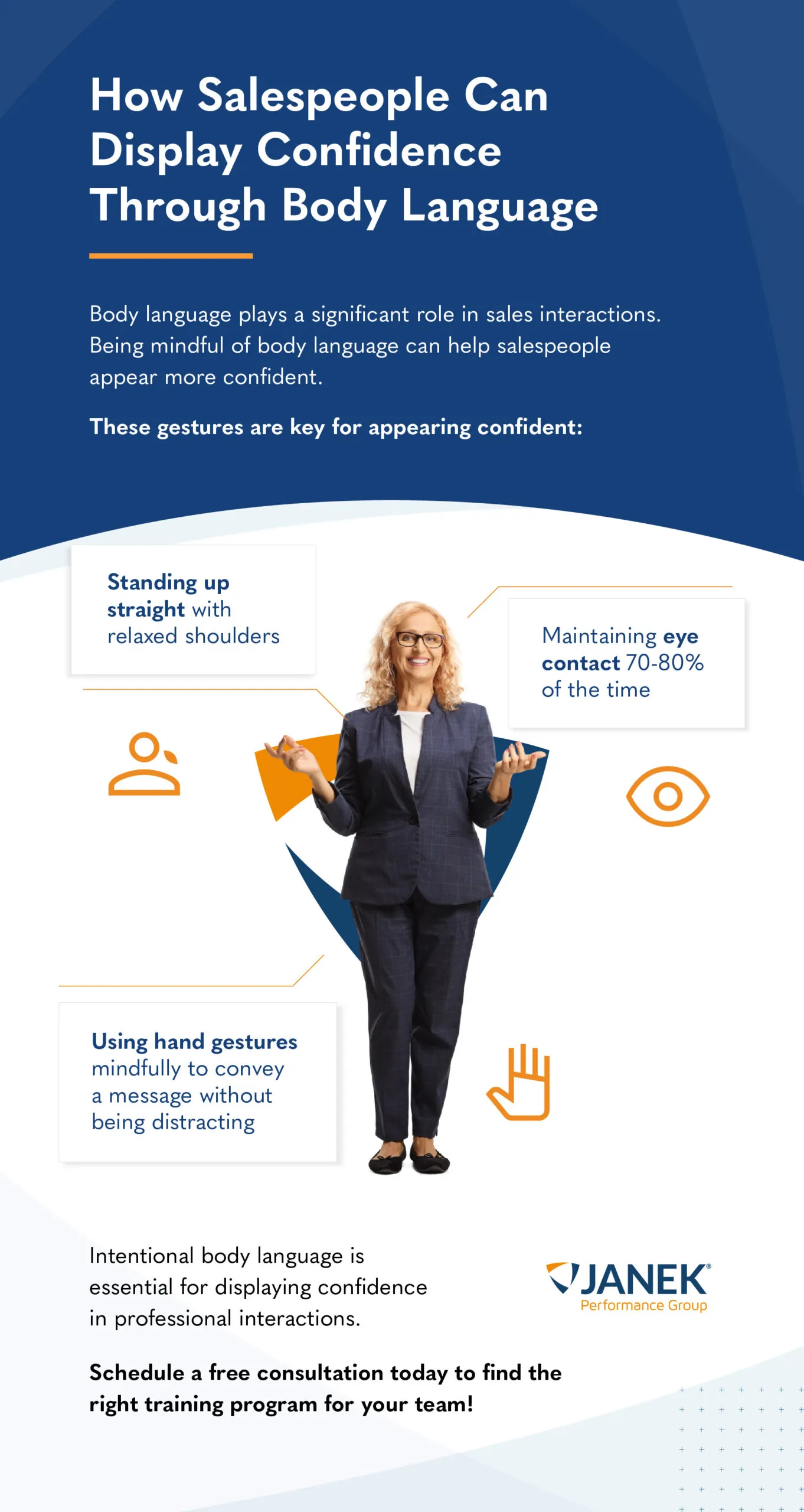Understanding Your Prospect’s Body Language

Most salespeople people have a basic understanding of body language. After all, we “hear” and “speak” it every day. This makes it easy to take it for granted, especially with prospects. With so much attention devoted to what prospects say, we often neglect the vital information their bodies reveal.
In the 1960s, psychology professor Albert Mehrabian developed the 7%-38%-55% rule. This stated only 7% of communication is verbal alone. Additionally, 38% is nonverbal (such as tone), and 55% is visual (body language and expressions). Although often misinterpreted to state 90% of communication is nonverbal, the basic premise holds. In fact, the Nonverbal group estimates between 60 and 90% of daily communication is nonverbal.
Regardless of a specific number, it’s clear body language is a significant aspect of communication. This makes it a critical component of selling. Here, we will examine how sellers can better understand body language to achieve greater sales success.
What Body Language Is
Body language is variously defined as a nonverbal vocabulary, a range of signals, or physical communication. It’s also instinctive or unconscious, something we do naturally and continuously, without thinking. It either puts people at ease or makes them uncomfortable, builds trust or offends. And it can strengthen or undermine arguments and agreements. Thus, it is a powerful tool for salespeople.
All languages have grammar. It’s how words and phrases are put together. Without it, communication can be strained. A recipient may understand individual words but still misunderstand the larger context. Now, let’s examine the nouns, verbs, adjectives, and adverbs of body language.
Understanding a Seller’s Body Language
Of course, selling is providing goods and services in exchange for payment. But in B2B, it’s often less about products and how they perform than about people and how they feel. In this, the conscious use of body language can influence a sales interaction or negotiation.
For salespeople, body language is critical to:
- Display confidence
- Establish rapport
- Control emotions
- Demonstrate equality
Here, we’ll investigate how sellers can be more deliberate with their body language to better communicate with prospects.
Confidence
Real confidence is internal. It’s the physical manifestation of knowledge, experience, and expertise. Fake confidence is arrogance. It’s sellers putting their needs above customers or placing themselves in a position of power. Often, posture is the first thing a prospect or client will notice. Standing up straight, with shoulders back and relaxed, displays a genuine confidence that inspires.
Also, pay attention to the movement of your arms. Some sellers speak with their hands, and this can be helpful to convey interest and excitement. But too much can be a distraction and obscure your meaning or dull your message.
Eye contact is crucial. Even prospects with a rudimentary knowledge of body language will interpret a lack of eye contact as insincerity. Or they might think you’re not interested. On a basic level, not looking at someone during conversation makes them uncomfortable.
This is as true in virtual as it is in person. But remember, in virtual, looking at your screen will appear as if you’re looking down. For eye contact, look directly into your camera. For maximum effect, maintain eye contact as much as 70-80% of the time. We’ll look more deeply into the prospect’s eyes below.
Rapport
Productive relationships start with positive rapport. And your body language lets prospects see for themselves the truth and validity of your talking points. For example, consider your speech pattern. Too fast and you’ll rush a prospect or generate anxiety. Too slow and you could appear like you’re talking down to them. In the same way, whenever possible, position your body to display openness. Start with shoulders. These should be relaxed and face the prospect.
Emotions
Controlling one’s emotions—or, more importantly, the perception of those emotions—is crucial. Think about your hands and arms. If your hands are clenched, you appear tense. Similarly, crossed arms convey a closed off or inflexible position. The same goes for legs and feet. Like shoulders, keep your feet directed at the prospect. No matter the tenseness of a situation, the conscious use of body language conveys control.
Equality
For collaborative negotiations, a sense of equality is vital. While sellers should seek advantages, a level playing field is key in collaborative negotiations. Understanding body language helps sellers make prospects and buyers more comfortable, increasing collaboration.
Understanding a Prospect or Client’s Body Language
Now, let’s examine what a prospect’s body language says. Generally, body language reading often centers on four main areas:
- Posture
- Face/Eyes
- Hands/arms
- Feet/legs
Posture
A prospect’s mid-body posture says a lot. If they are open to your sales pitch, they will often lean toward you. When they’re engaged in the conversation, they might unconsciously mirror your movements. It’s instinctive, and Macaque monkeys do it as well. It conveys connection.
A rigid, uncomfortable posture means anxiety. If you notice this in your prospect, put them at ease. A good start is adjusting your body to an open position. Sit facing them. Keep your hands and arms in a neutral position. This can be at your side or on the table before you.
Bored or disengaged prospects often display a closed-off posture: hunched shoulders, crossed arms, fidgeting hands. Are they spinning or clicking a pen while you speak? Uh huh. Bored. Crossed legs are another example of being closed off. Unconsciously, it can signal a need for protection.
Facial Expressions
Facial expressions are not as simple as smiling or frowning face emojis. Of course, if prospects are smiling and nodding, keep doing what you’re doing.
In addition, whether in person or videoconferencing, note the prospect’s lips. Are they relaxed or, when pressed together, are they pulled inward? This could be a sign of tension, frustration, or disapproval.
Facial twitches can indicate disbelief or cynicism. Silent judgement could manifest as flared nostrils. If a prospect’s nostrils are wigging out, your prospect might be wigging out internally. Wrinkling the nose could mean they think your current offer stinks. When this happens, seek clarification and, if needed, add value to sweeten it up.
The Eyes Have It
Eyes give you a view into the prospect’s attention, sincerity, and even trustworthiness. When video conferencing, eye contact is the only body language available. So being well-versed in the subject is essential.
For example, if the prospect makes frequent eye contact, they’re interested in what you have to say. Also, in virtual, pay attention to where your prospect looks. For example, if they scan to the corners of their computer, they may be checking the time.
Generally, people look at what they are thinking about. This does not mean they fixate and stare. But their gaze will return to the object repeatedly. If it’s their watch, they’re thinking about time. If it’s the door, they probably want out. Plus, the area around the eyes is important. A tensed forehead could mean one’s confused, frustrated, or surprised.
In addition, eyes can fidget as much as hands. If your prospect’s eyes dart around the room, they most likely feel rushed or impatient. Consider open-ended questions. This can divert their attention back to the discussion.
If pupils are wide and open, the prospect is engaged. If they are narrow, they could be upset, concerned, or angry. Therefore, steer your discussion away from what narrowed their pupils and concentrate on what opened them.
Hands and Arms
As anyone with sign language or ASL experience knows, hands are extremely important communicators. And for most people, this includes arms.
For example, drumming fingers may indicate boredom or impatience. However, most prospects know enough to not appear rude. Instead, it may be more subtle, such as the occasional finger tap or drumming on their thighs.
Always note pen twirlers and paper shufflers. While some people are simply nervous, these signs can also be signals of impatience. When you notice this, stop talking. Instead, direct the prospect to elaborate or explain.
Leaning on an armrest can simply be comfortable. It can also indicate a desire to leave the room. A good tell is the amount of pressure they seem to exert and if they lean toward the door.
Crossed arms could indicate the prospect is simply cold. More often, it’s a sign of being closed off. Once again, display openness in your own body language to inspire mirroring. And invite further openness with open-ended questions.
Legs and Feet
And finally, the legs. Have you ever sat next to a leg fidgeter in a waiting room? You know, the person whose leg goes up and down and makes you want to scream, “Relax!” That’s negative body behavior.
Leg and arm movement are often one with each other. Picture a person with crossed arms and legs, one leg bouncing on the other to an internal beat. You’re looking at a pretzel person, someone who is not open at all.
As most people don’t think about their feet, they are fascinating for body watchers. Remember, if someone is open to you, their feet will typically point to you. If their feet are askew, it could signal avoidance.
In sales, it is vitally important to pay attention to body language and to know it fluently.
Eye Contact Is Not Just for Prospects Anymore
As a sales rep, it’s equally important for you to make and maintain eye contact. Even a prospect with a rudimentary knowledge of body language will interpret limited to no eye contact as insincerity on your part—and/or they’ll think you’re not interested in the transaction. On a basic human level, it makes people uncomfortable not to be looked at during conversation. Body information in the vicinity of the eyes is also important. A tensed forehead means you could be suffering from the following conditions:
- Confusion
- Frustration
- Surprise
Always make eye contact with your prospect, especially when they’re speaking. They need to know they have your full attention.
The Facial Expression That Launched a Thousand Words
Whether meeting in person or via video conferencing, what you’re looking for is more subtle than the easily understood bubbly smile or blubbering sadness. Are the lips relaxed, for example? When they’re pressed together and pulled inward, they’re saying, “I’m tense,” or “I’m frustrated,” or “I disapprove of what I’m hearing.” Facial twitches indicate disbelief or cynicism. Silent judgement sometimes manifests in the form of flared nostrils: If they’re winging out, your prospect might be wigging out. Wrinkling the nose informs you that the prospect does not support what they see as a stinky deal.
Torso and Arms
Mid-body posture says a lot. If the prospect is open to what you’re saying and interested in hearing your sales pitch, probably they’re leaning toward you. When they’re engaged in the convo and trying to be friendly, they might unconsciously mirror your movements. Macaque monkeys do this as well; so do you! It conveys connection.
Bored, Stiff…
You’ll know your prospect is bored if they display a closed-off posture: hunched shoulders, crossed arms, fidgeting hands. Are they spinning or clicking a pen while you speak? Uh huh. Bored.
A rigid, uncomfortable body posture means anxiety.
Your own posture is of the utmost importance as a sales professional because, whether consciously or unconsciously, it will be read by the prospect. Your slouching shoulders signal weariness and the opposite of confidence. Body language is very literal. Keep your back straight and your chest open, and lean in slightly as you engage with the prospect.
Pretzel Person
And finally, the legs. You ever sit next to a leg fidgeter in a waiting room? You know, the guy whose leg goes up and down really fast over and over till you want to scream “Relax!” That’s a negative body behavior. Leg and arm movement are often one with each other: The arms are crossed, the legs are crossed, and one leg is bouncing on the other to beat the band. Suddenly you’re looking at pretzel person, or … someone who is not open at all.
So know your body English when you go forth and sell. And ask yourself, “Read any good people lately?”
Updated 07/11/2024
- What Body Language Is
- Understanding a Seller’s Body Language
- Confidence
- Rapport
- Emotions
- Equality
- Understanding a Prospect or Client’s Body Language
- Posture
- Facial Expressions
- The Eyes Have It
- Hands and Arms
- Legs and Feet
- Eye Contact Is Not Just for Prospects Anymore
- The Facial Expression That Launched a Thousand Words
- Torso and Arms
- Bored, Stiff…
- Pretzel Person

- Account Planning (11)
- Awards (50)
- Client Testimonial (37)
- Personal Branding (19)
- Podcast (11)
- Research (68)
- Sales Career Development (85)
- Sales Coaching (153)
- Sales Consulting (133)
- Sales Culture (164)
- Sales Enablement (340)
- Sales Leadership (108)
- Sales Management (242)
- Sales Negotiation (16)
- Sales Prospecting (124)
- Sales Role-Playing (18)
- Sales Training (229)
- Selling Strategies (255)
- Soft Skills (67)
- Talent Management (92)
- Trusted Advisor (27)
- Virtual Selling (41)
- Webinar (10)






























